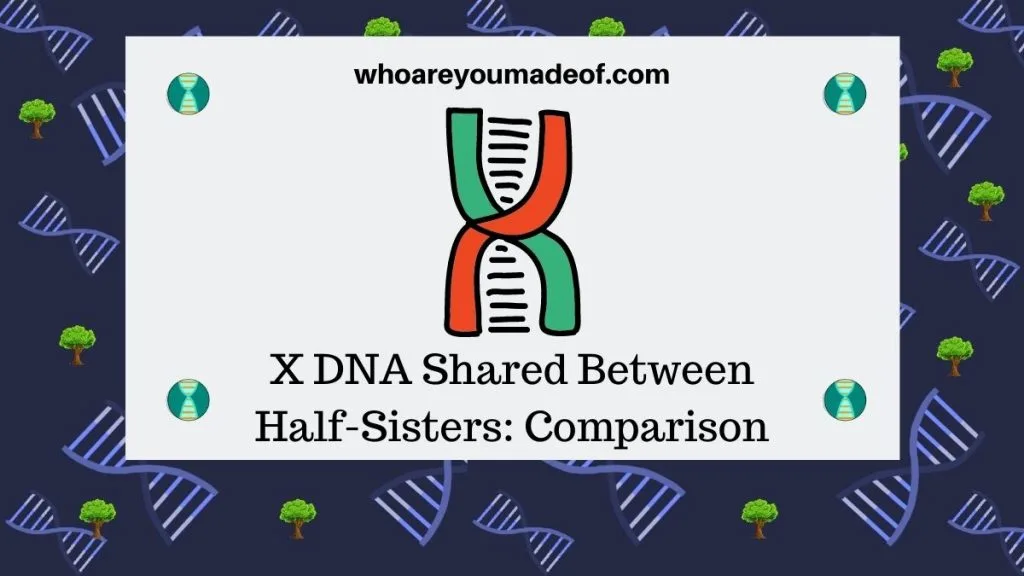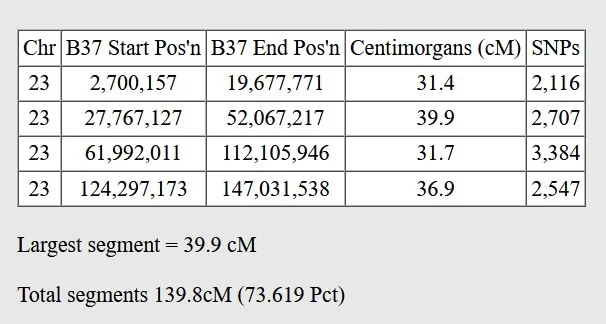Do you need to see a comparison of shared X-DNA between half-sisters with the same mother? In this post, learn how much X-DNA is shared between two maternal half-siblings.
Plus, I will provide you with an explanation of how X-DNA is passed down from a mother to her children. This will help you understand more about X-DNA and make more sense of your close DNA matches.
For the purposes of this article, a maternal half-sibling is defined as two siblings who share the same mother and have different fathers.

It is important to note that siblings with the same mother, whether male or female, will always share X-DNA. Because of the way that X-DNA is inherited, however, a brother and sister who only share a father will not match on the X-chromosome.
You can read more about the general patterns of X-DNA inheritance in the following post: Got questions about the X-chromosome?
Below, we will continue our discussion about shared X-DNA between half-siblings with the same mother. Our example for the post includes X-DNA shared between two half-sisters with the same mother and a different father.
How do half-sisters with same mother match on the X chromosome?
Half-sisters and brothers with the same mother will always share X-DNA. All children inherit a "recombined" version of their mother's two copies of the X chromosome.
As you might already know, females have two copies of the X chromosome. This is why you see females sometimes notated as "XX".
When a female has offspring, she passed down a brand-new, completely unique X chromosome to her children. Each child gets a copy from their mother that has gone through the process of recombination.
Recombination of the X chromosome is simply a unique copy that is made up of randomly selected pieces from both copies of the mother's X chromosome. Some of the X chromosome will have come from the mother's paternal copy and some from the mother's maternal copy.
The end result is that two children with the same mother and different father will share bits and pieces of identical X DNA. This is due to the random nature of the recombination process.
In other words, some X DNA between maternal half-siblings will be identical and some will be different.
In the image below, we see a comparison between two half-sisters with the same mother. They share a total of 73.619% of their X DNA, totaling about 139.8 centimorgans.

What we understand from this image is that about 73% of these sisters' X DNA is identical. The random selection process of recombination left these sisters with a great portion of their X DNA matching identically over four DNA segments.
Still, about 27% of their X DNA is different. All of their X DNA, even the DNA that doesn't match, was inherited from their mother.
What about half-brothers and sisters? The way X DNA is inherited by males is a little different.
Males only inherit X-DNA from their mothers. They inherit a Y chromosome from their father, which is why we sometimes see males described as "XY".
Some DNA testing sites allow comparison of X-DNA. For example, 23andMe does show matching DNA in the 23andMe chromosome browser.
If you and your potential maternal half-sibling didn't test with 23andMe or Family Tree DNA, or you tested with different DNA testing companies, don't worry. There is still a way that you can compare your X-DNA.
The easiest way to compare your X-DNA with a DNA match is by using the Gedmatch site. It's free and easy to use the X-DNA Comparison tool available on the site.
In order to use this tool, however, both you and your DNA match must upload your DNA.
For your reference, here are a two helpful Gedmatch articles to help you get started, if you are not yet familiar with the site:
How much X-DNA do maternal half-siblings share?
There is no exact range for shared X-DNA between maternal half-siblings, but we do know that maternal half-siblings will always share a substantial number of centimorgans on the X chromosome. In addition, we usually expect the shared DNA between siblings with the same mother to be spread over a few different DNA segments.
The same cannot be said for paternal half-sisters. Females inherited an entire X-chromosome, completely intact, from their fathers.
This means that two sisters, females with the same father, will share an entire X-chromosome. Full sisters, females who share a mother and a father, have two copies of the X chromosome.
These sisters who share both parents will have one copy of their X chromosome match their sister exactly. The other copy of their X chromosome will match similarly to the maternal half-siblings described in this article.
Their partial match on one copy, and partial match on the other, is due to the recombined X chromosome inherited from their shared mother and the fully intact copy inherited from their shared father.
Note: It is possible for a mother to pass down an un-recombined X-chromosome to a child, but this is an uncommon scenario. It is even more unlikely for two of her children to receive the same intact chromosome.
Can X-DNA help you know if your half-sibling shares a mother with you?
No, you cannot use X-DNA on its own to determine whether your DNA match is a maternal half-sibling. The amount of shared X-DNA shared between half-siblings with the same mother is similar to what we expect to see between certain other close relatives.
Since males only inherit X-DNA from their mother, we can be sure that lack of shared X-DNA can eliminate a maternal half-sibling as a possibility, however. In other words, a male would definitely share X-DNA with a maternal half-sibling.
If a male shares no X-DNA with a close relative, we can eliminate maternal half-sibling as a possible relationship.
Conclusion
I hope that this post has helped you understand more about the X-DNA shared between half-sisters, and even half-siblings, with the same mother. If you have any questions about something that you read in this post, I would love to hear from you in the discussion below.
Thanks for stopping by!


Jean Beck
Sunday 28th of May 2023
Hi. My name is Jean Beck. I share a mother with my half sister but on our shared chromosome under the X chromosome, nothing is shaded. We did 23andMe. Is this possible and what does it mean? If you want to see our shared chromosome and her percentage that we share, I can easily send you.
Jean Beck
Elizabeth
Tuesday 22nd of March 2022
Is it possible to share 77.128% X DNA with a female that is not your sister?
I know we do not have the same mother, but GED match report states that my parents are probably related, would that cause such a high X-DNA match with someone that is not my sister or would that mean we have possibly the same father?
Elizabeth
Tuesday 22nd of March 2022
@Elizabeth,
well actually...maybe not because our Total CM is 191.7, so with the high X-DNA match would that mean a possibility that her father's brother could be?
Sorry, just confused as to how we could have such a high X-DNA match and a low Total CM match.
Shannon
Tuesday 8th of February 2022
I share 2560cm 191 longest 37.5 percent no x dna is this my real brother and 43 sagmates
Barbara
Friday 26th of February 2021
My maternal half-sister and I DO NOT share any X-DNA. We are half-sisters and share approximately 20% DNA. We both tested on 23 and Me.
Can you explain this in light of the article you have written. Thank you!
Pj
Friday 4th of March 2022
@Mercedes,
I am female who shares no X with my half sister. Also we are all half siblings - I share some x with half brother and also half sister. They share the most X chromosome genes. Can this really happen? Thanks
Pj
Wednesday 16th of February 2022
@Mercedes, Me and my two siblings have found out we are all half siblings (we were all adopted). My half brother and I share small part of X chromosome (share 25.55% overall dna). My half brother and my half sister share almost all of X chromosome, but not all (26.70% overall dna match). But then I share zero part of X chromosome with my half sister (27.15% overall dna match). We presume we all share a mother (we don’t know this for sure) but how could it be that my half sister and I share no X chromosome? I am baffled by this but you are saying that statistically this could be possible (as original questioner inquired about)??? Is there a possibility that my brother and I are paternal half siblings, in which our separate mothers are full sisters (half dna match) that could show for the 27.15% match with a so called half sister??? What are the rates of dna match among half siblings that have different parent who are full siblings??? Hope it is just a simpler case of all maternal half siblings (not that that’s simple at all!).
Thank you and would love your help in trying to figure out this family tree puzzle among half siblings!!
Mercedes
Saturday 27th of February 2021
Hi Barbara, Thank you for your very interesting question! So, it is theoretically possible for two maternal half sisters to share no X-DNA. It's not very common, however - so you and your sister are unique. Because of the size of the X chromosome we can expect crossover to occur (the process that results in the recombination of the two copies of the chromosome) to occur about 1.5 times, which would result in maternal sisters sharing about half of their X chromosome. This is only an average, though. One scenario could be if crossover occurred much more than we usually see, you and your sister could have inherited many completely different segments of the X chromosome from your shared mother. Or, crossover occurred only once or twice for both of you, and you got each got the "opposite" DNA. In other words, one of you inherited all of the X DNA from your shared mother that the other didn't inherit. I have no data on how often this actually happens, of course - we just know that it could happen. I hope that this explanation helps - I only wish I had some research to link to. Sincerely, Mercedes